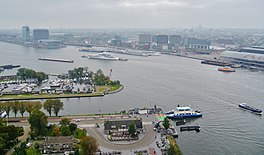IJ (Amsterdam)
This article needs additional citations for verification. (May 2023) |
| IJ | |
|---|---|
 The IJ in 2017 | |
| Location | Amsterdam, Netherlands |
| Coordinates | 52°22′51″N 4°56′38″E / 52.38083°N 4.94389°E |
The IJ (Dutch: [ɛi̯] ⓘ; sometimes shown on old maps as Y or Ye) is a body of water, formerly a bay, in the Dutch province of North Holland. It is known for being Amsterdam's waterfront.
Etymology
The name IJ is derived from the West Frisian word ie, alternatively spelled ije, meaning water and cognate with the English word ea.[1] The name consists of the digraph ij which is capitalized as IJ.
Geography


Today, the IJ is divided into two parts:
- To the west of the Oranjesluizen (Oranje Locks), the Binnen-IJ (inner IJ), or Afgesloten-IJ (closed IJ), is directly connected to the North Sea Canal, where the port of IJmuiden and the North Sea can be reached.
- To the east of the Oranjesluizen, the Buiten-IJ (outer IJ) is an extension of the IJmeer which is itself an extension of the Markermeer.
The IJ is connected to the North Sea to the west and the IJmeer to the east by a set of
History



There are several theories about the origins of the IJ. Perhaps it began as a stream, following a breakthrough in the dunes of Castricum. More likely, the IJ is a remnant of a northern arm of the
At the end of the
Plans were put forth to
The Buiten-IJ hosted the mixed dinghy sailing events for the 1928 Summer Olympics in neighboring Amsterdam.[2][3] It also hosted two events for the 1920 Summer Olympics in Antwerp.[4]
The nautical event SAIL Amsterdam takes place on and around the IJ.
References
- ^ M. Philippa, F. Debrabandere, A. Quak, T. Schoonheim & N. van der Sijs, "A - (stromend water, riviertje)" (in Dutch), Etymologisch Woordenboek van het Nederlands, 2003–2009. Retrieved on 17 October 2020.
- ^ 1928 Summer Olympics official report, featuring map of the Buiten IJ. pp. 271–2, 274.
- ^ "Sailing at the 1928 Amsterdam Summer Games: Mixed One Person Dinghy | Olympics at Sports-Reference.com". 2015-04-02. Archived from the original on 2015-04-02. Retrieved 2021-10-02.
{{cite web}}: CS1 maint: bot: original URL status unknown (link) - ^ "Sailing at the 1920 Antwerpen Summer Games: Mixed 12 foot | Olympics at Sports-Reference.com". 2012-11-03. Archived from the original on 2012-11-03. Retrieved 2021-10-02.
{{cite web}}: CS1 maint: bot: original URL status unknown (link)
External links
 Media related to IJ at Wikimedia Commons
Media related to IJ at Wikimedia Commons


